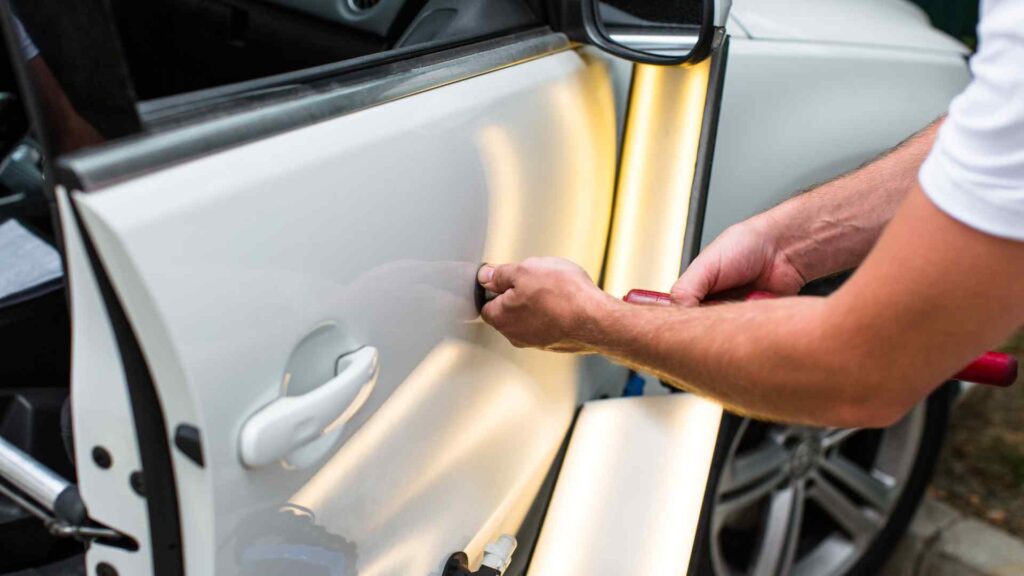How To Fix Car Dents: 8 DIY Hacks to Save You Money
Dents can be a frustrating part of car ownership. Whether it’s a minor ding from a shopping cart or a larger dent from an unfortunate parking mishap, these imperfections can detract from your car’s appearance and value. Fortunately, with the right techniques, you can fix car dents yourself, saving both time and money.
In this article, we’ll look at a few useful DIY car dent repair techniques, as well as when you should look for professional dent repair from pros like YST Auto Service.
How To Fix Car Dents: 8 DIY Hacks to Save You Money
8 Easy Ways to Repair Dents Yourself
When dealing with a dent in their automobile, many drivers choose to fix it themselves before hiring expert car dent repair services. DIY solutions can be effective, economical, and enjoyable. Here’s a detailed look at the top eight DIY auto dent repair solutions, along with instructions and advice for effective performance.
Hair Dryer and Aluminum Foil Method
One of the most popular methods for removing car dents is to use a hair dryer and compressed air. This procedure infuses hot and cold air, allowing the heat and rapid cooling to twist the metal back into shape, making it an excellent approach to repairing tiny dents.
Materials Needed:
- Hair dryer
- Aluminum foil
- Dry ice or a can of compressed air (upside down)
Steps:
Clean the Area: Wash the dented area to remove dirt and debris.
Heat the Dent: Use the hair dryer to heat the dent for about 30 seconds, keeping it a few inches away to avoid burning the paint.
Apply Aluminium Foil: Cover the heated dent with a piece of aluminium foil to protect the paint.
Cool the Area: Quickly apply dry ice to the foil or spray the area with compressed air held upside down. The sudden temperature change should cause the dent to pop back into place.
Inspect and Repeat: If the dent doesn’t fully pop out, repeat the process as necessary, ensuring to reheat and cool the area effectively.
Plunger Method
You can use a plunger to unclog a drain as well as remove small to medium-sized dents from your car. This approach is likely to remove a minor dent with ease. This works nicely on doors or side panels because the suction is created, pulling the damage right out. This simple yet efficient procedure works best for shallow, circular dents.
Materials Needed:
- Cup plunger (not a flange plunger)
- Water (to aid suction)
Steps:
Wet the Plunger and Dent: Moisten both the edge of the plunger and the area around the dent to create a better seal.
Position the Plunger: Firmly place the cup of the plunger over the dent.
Pull with Steady Force: Pull the plunger straight out with a steady motion. The suction should help pull the dent out.
Repeat if Needed: If the dent doesn’t pop out on the first try, reposition and attempt again.
Boiling Water Method
Today’s vehicles have plastic bumpers, which make them more bendable for removing dents. If you have damage in your automobile or truck’s bumper, remove it and use hot water to help press the dent out of the plastic. This approach is very helpful for dents found on plastic pieces like bumpers.
Materials Needed:
- Boiling water
- Rubber mallet or your hands
Steps:
Boil Water: Bring a pot of water to a boil.
Pour Over the Dent: Carefully pour the boiling water over the dented area to soften the plastic.
Push from Behind: If accessible, reach behind the panel and gently push the dent from behind. If not, use a rubber mallet to tap from the outside.
Cool Down: After pushing the dent out, pour cold water over the area to harden the plastic back into shape.
Hot Glue and Pulling Method
This solution requires some engineering, but it is an effective way to avoid chipping your vehicle’s paint. Using hot glue is a practical method that works well for a variety of dent sizes.
Materials Needed:
- Hot glue gun
- Wooden dowel or a puller tool
Steps:
Clean the Dent: Ensure the area around the dent is clean and dry.
Apply Hot Glue: Use the hot glue gun to apply a generous amount of glue to a wooden dowel or puller tool.
Stick to the Dent: Press the glued end firmly onto the centre of the dent and let it set for several minutes.
Pull the Dent: Once the glue is set, pull on the dowel or tool with steady pressure until the dent pops out.
Remove Residue: Carefully remove any remaining glue using rubbing alcohol.
Dent Repair Kits
If you prefer a more structured method, investing in a dent repair kit will make the procedure easier. With some effectiveness, these products are designed to release dents by pulling them out with a specific amount of pressure. Do your research before purchasing these products, as not all of them are designed to deliver the outcomes you expect.
Materials Needed:
- Dent repair kit (available at auto parts stores)
- Heat source (optional, for deeper dents)
Steps:
Read the Instructions: Each kit comes with specific instructions; be sure to follow them closely.
Prepare the Area: Clean the dented area thoroughly.
Attach the Pulling Tool: Most kits have a pulling tool with adhesive. Apply the adhesive to the tool and press it onto the center of the dent.
Allow to Set: Follow the kit’s instructions regarding how long to let the adhesive cure.
Pull the Dent: Use the included pulling mechanism or a manual pull to remove the dent.
Finish Up: Remove any remaining adhesive and clean the area.
Using Dry Ice
Dry ice can eliminate minor dents by rapidly chilling the metal. Dry ice, while mostly employed as a cooling agent, can also be used to remove small dents from your car. While you may need to wear hand protection when handling dried, this process will produce results pretty fast. Apply dry ice directly to the dent, holding down a piece of dry ice and rubbing it around until you hear the dent pop back into place.
Materials Needed:
- Dry ice
- Protective gloves
Steps:
Wear protective gloves: Handling dry ice with bare hands can cause burns.
Rub the dry ice on the dent: Apply dry ice directly to the dented area for about 30 seconds.
Wait for the metal to contract: The cold temperature causes the metal to shrink, making the dent pop out.
Repeat if necessary: Try multiple applications for deeper dents.
Using a Vacuum Cleaner and a Bucket
To remove a dent, you might use a vacuum cleaner and a bucket. However, getting a powerful enough dent puller can be challenging. A solid vacuum cleaner may provide suction powerful enough to remove dents.
Materials Needed:
- A vacuum cleaner
- A small bucket with a hole cut in the bottom
- Duct tape (optional, for sealing gaps)
Steps:
Create a seal: Cut a hole in the bottom of a bucket and attach the vacuum hose to it.
Place the bucket over the dent: Ensure an airtight seal around the dent.
Turn on the vacuum: The suction should pull the dent outward.
Adjust as needed: If the dent remains, reposition and try again.
Using Wooden Dowels and Screws
For deeper dents, wooden dowels can provide leverage to pull out the dent.
Materials Needed:
- Wooden dowels
- Screws
- Strong adhesive (such as hot glue)
- Rubbing alcohol (for glue removal)
Steps:
Attach screws to wooden dowels: Insert screws into both ends of the dowel.
Glue the dowel to the dent: Apply strong adhesive and press the dowel onto the dent.
Pull gently: Use the dowel to pull the dent outward.
Remove and clean: Once the dent is gone, remove any glue residue.
DIY vehicle dent removal techniques can be both successful and profitable. Each treatment has advantages, so select one that is right for the type and location of the dent. Heat and cool techniques, simple suction, and specialized kits can all help you save money while also repairing the look of your vehicle.
Always carefully assess the damage and use the procedure that is most appropriate for your situation. If DIY approaches are not enough or the damage is serious, do not hesitate to get specialist assistance.
When to Consider Professional Help
If you’re confused about the scope of your coverage or the following steps, speaking with a professional dent repair specialist can help. They may also aid with the insurance process by offering thorough estimates and damage evaluations.
YST Auto Service is an excellent choice for professional dent repair. Our dedication to quality, convenience, and customer satisfaction makes us an outstanding choice for drivers looking for efficient solutions to minor dents and dings. With a team of qualified technicians, a wide range of services, and an emphasis on fair pricing and sustainable techniques, YST Auto Service is well-equipped to handle your dent repair needs promptly and professionally. Whether you have a minor dent or significant damage, trusting YST Auto Service ensures your vehicle receives the care it deserves.
For those who prefer professional assistance, YST Auto Service provides experienced mobile dent repair to keep your vehicle looking its best. By taking proactive steps to address dents, you can maintain your car’s appearance, value, and longevity.






